Menus
- Clash of generations
- The 999 completely misses the latent aggressiveness of the Panigale
- Clear differences on the handling test route
- Data Ducati 999 S / Ducati 1199 Panigale S.
- Rating Ducati 999 S / Ducati 1199 Panigale S
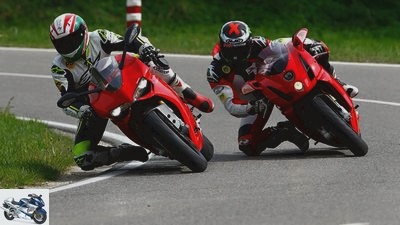
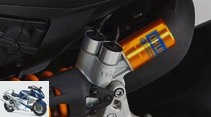
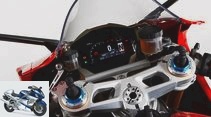
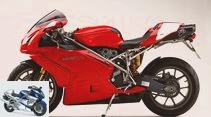
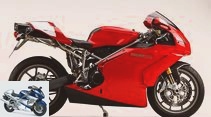
14th photos
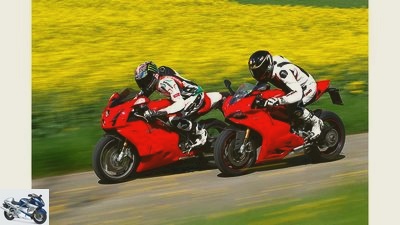
1/14
The rattling through the city with the Ducati 999 S is deep in the memory. But honestly, the current Ducati Panigale with the hacking short-stroke twin and this crazy hot exhaust air in the crotch is exponentially more annoying.
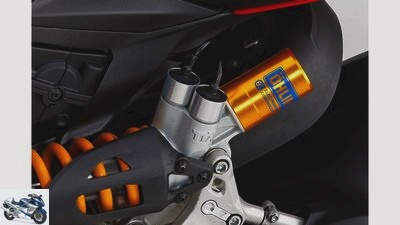
2/14
The electronic chassis – a few fingertips on the display against counting clicks with a screwdriver.
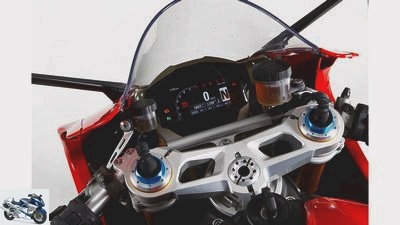
3/14
The Panigale scores well in electronics.
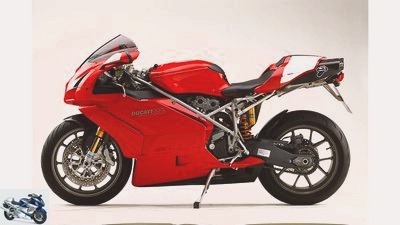
4/14
The fork was revised by HH-Racetec shortly before our test, which is why the beautiful response is definitely on Hubert Hoffmann’s cap, but on our handling test route the 999 revealed that there are ten heavy development years between it and the new superbike.
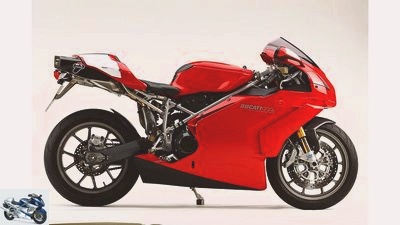
5/14
The Panigale reveals a completely different character. Somehow it’s not that twin feeling anymore.
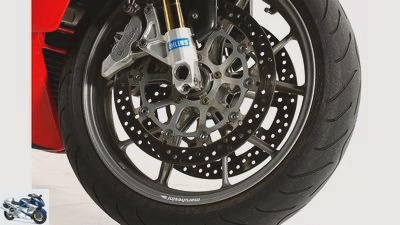
6/14
The 999 Brembo stoppers with four-piston fixed calipers are still at a good level.
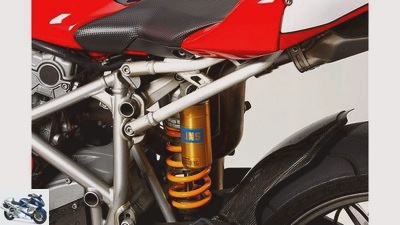
7/14
Manual work is still required for the chassis.
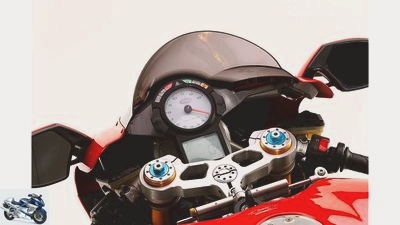
8/14
The Ducati 999 S cockpit.
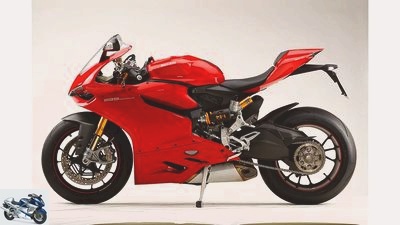
9/14
Needless to say, we don’t need to say a lot about the electronic advantages of the Panigale.
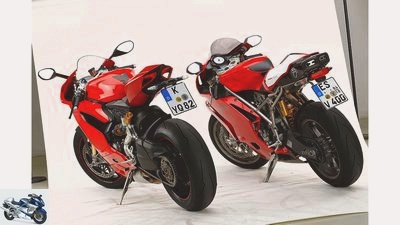
10/14
The huge adjustment range of the electronic system of the Ducati 1199 Panigale S reduces this a little more than the conventional Ohlins strut of the 999, but in the high-speed range both look almost the same as a rigid frame.

11/14
The same basic construction from the 999 S on the Panigale, but radially hinged and 330 mm instead of 320 mm discs.

12/14
The Panigale believe it can afford this mighty performance gap between 5000 and 7000 rpm. Definitely on the racetrack, but I’ll stick with it on the country road, the 999 twin is still the more enjoyable engine today.
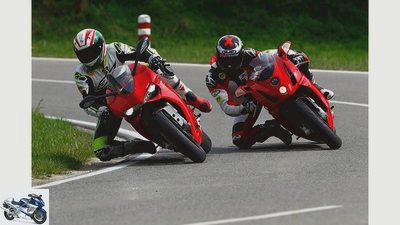
13/14
In the end, the Panigale clearly prevails because a lot has happened in ten years.
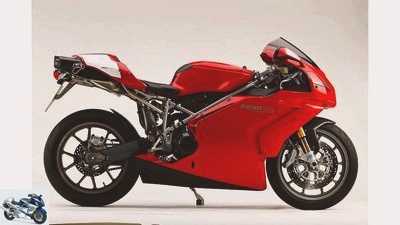
14/14
The 999 completely misses the latent aggressiveness of the Panigale.
Ducati 999 S and Ducati 1199 Panigale S in comparison test
Clash of generations
Content of
It was the first superbike that Uwe Seitz got his hands on after joining PS in 2004: the Ducati 999 S. In a comparison test with the Ducati 1199 Panigale S, the managing editor explains what has happened to the sporty Italian woman over the past ten years Has.
Okay, in fact it was the hot R version back then, but when I got back into the saddle of the Ducati after ten years 1199 Panigale S swinging, this feeling from back then is immediately awakened. The hard seat pan, the stumps lying far in front and below, this ultra-slim tank with the mighty twin underneath elicit the same “wow” that made me roll from the courtyard with awe.
Buy complete article
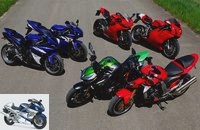
Ducati 999/1199, Kawasaki Z 1000 and Yamaha YZF-R1
Generation comparison – 10 years apart
Ducati 1199 Panigale S with the hacking short-stroke twin and this crazy hot exhaust air in the step exponentially annoying. In the first bends, the ten-year-old diva then demands recognition, because this engine from back then was a really great drive on country roads compared to today’s. It pulls through very smoothly from 3500 rpm, the smoothness is remarkable. Along the small Black Forest river on the well-developed and beautifully curved road, the Ducati 999 S conveys that beautiful superbike feeling, where everything can but does not have to be.
The 999 completely misses the latent aggressiveness of the Panigale
The Ducati 999 S completely misses the latent aggressiveness of the Ducati 1199 Panigale S. You may therefore perceive the 999 engine as a bit tough and, in direct comparison, accuse it of a lack of revving and a bit of stubbornness, but you can also stroll with it, a gear higher or lower does not matter to the 90-degree V – the Panigale can’t do that at all. In addition, the gentle throttle response and the linear performance curve – top notch! The Panigale reveals a completely different character. Somehow it’s no longer the twin feeling that the 999 passed on to the 1090 almost without further ado.
After the Ducati 999 S, the Testastretta looked much more revving and more speed-oriented, but what the current superbike is doing is simply the famous paradigm shift. Today, speed and top performance are everything, more four-cylinder than the typical twin feeling. This is probably why the Ducati 1199 Panigale S believes it can afford this mighty performance gap between 5000 and 7000 rpm. Definitely on the racetrack, but I’ll stick with it on the country road, the 999 twin is still the more enjoyable engine today.
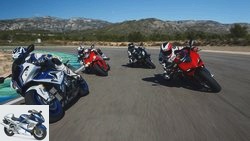
Super athlete
Test: BMW S 1000 RR against HP4 and Ducati 1199 Panigale against Panigale S.
Race track comparison: BMW and Ducati super sports cars
read more
All articles about the Ducati 999
Clear differences on the handling test route
Their brakes are still up to date. The Brembo saddles from back then lacked the ultra-brutal bite of the current monoblocks, but the Ducati 999 S was also a big hit. The raised Metzeler Sportec M5s are blamed. The fork was revised by HH-Racetec shortly before our test, which is why the beautiful response is definitely on Hubert Hoffmann’s cap, but on our handling test route the 999 revealed that there are ten heavy development years between it and the new superbike. How the Ducati 1199 Panigale S steers in, stays in lane, drives even tighter lines with light impulses and can be turned around in alternating curves is unbelievable, especially in direct comparison with its ancestor, which requires more effort and yet never achieves such agility better. In addition, the 999 lurches with its rear end before every bend when downshifting – of course, an anti-hopping clutch was unusual back then.
Both Ohlins chassis demand hardness from their drivers, and the rear section in particular seems terribly overdamped on both uneven country roads. The huge adjustment range of the electronic system of the Ducati 1199 Panigale S reduces this a little more than the conventional Ohlins strut of the 999 (see setup in the data box), but in the high-speed range both look almost the same as a rigid frame. We don’t need to say a lot about the electronic advantages of the Panigale: one has everything, the other nothing. In the end, the Panigale clearly prevails because a lot has happened in ten years. And if the sitting posture on the Ducati 999 S was already compelling me to respect it, then the Panigale scores tremendously: active over the handlebars on the motorcycle towards deep and long – the development can be felt everywhere.
Data Ducati 999 S / Ducati 1199 Panigale S.
MOTORCYCLE
Let’s leave out the topic of top performance, it has so much more value in racing. The 999 turns nicely linearly through the speed range and delivers fine controllable torque that is suitable for country roads. The Panigale are lower speeds sausage, the only way to explain the trailer between 5000 and 7000 / min.
Ducati 999 S (2004)
| drive | Two-cylinder, 90-degree V engine, four valves / cylinder, 100 kW (136 hp) at 9750 rpm *, 106 Nm at 8000 rpm *, 998 cm³, bore / stroke: 100.0 / 63.5 mm, Compression ratio: 11.4: 1, ignition / injection system, 54 mm throttle valves, hydraulically operated multi-plate dry clutch, six-speed gearbox, U-Kat, chain |
| chassis & Brakes |
Steel tubular space frame, steering head angle: 65.5 / 66.5 degrees, caster: 97/91 mm, Wheelbase: 1420 mm, upside-down fork, Ø fork inner tube: 43 mm, adjustable in spring base, rebound and compression. Central spring strut with deflection, adjustable in spring base, rebound and compression. Suspension travel front / rear: 125/128 mm, Light alloy cast wheels, 3.50 x 17 / 5.50 x 17, front tires: 120/70 ZR 17, rear: 180/55 ZR 17, test tires: Michelin Pilot Power 3, 320 mm double disc brakes with four-piston fixed calipers at the front, 240 mm single disc with two-piston fixed calipers at the rear |
| performance | |
| Max. Rear wheel power ** | 92 kW (125 PS) at 270 km / h |
| Acceleration** | 0-100 km / h: 3.1 s 0-150 km / h: 5.3 s 0-200 km / h: 9.1 s |
| Draft** | 50-100 km / h: 5.6 s 100–150 km / h: 5.6 s |
| Top speed * | 271 km / h |
| measurements and weight | Length / width / height: 2030/780/1080 mm, seat / handlebar height: 810/830 mm, Handlebar width: 660 mm, 213 kg with a full tank, v./h .: 49.4 / 50.6% |
| consumption | Fuel type: Super unleaded. Average test consumption: 6.8 liters / 100 km, Tank capacity: 15.5 liters, range: 227 km |
| Set up | |
| Setup fork | stat. neg. spring travel: 36 mm, pressure level: 6 K open, Rebound stage: 16 K open, level: standard |
| Setup shock absorber | stat. neg. spring travel: 15 mm, pressure level: 14 K open, Rebound stage: 20 K open, level: standard |
| Base price (2004) | 20,995 euros (plus additional costs) |
| All damping settings counted from completely closed; static negative spring deflection standing vertically without driver; U = revolutions; K = clicks; * Manufacturer information; ** PS measurement |
|
Ducati 1199 Panigale S (2014)
| drive | Two-cylinder 90-degree V engine, four valves / cylinder, 143 kW (192 hp) at 10,750 rpm *, 132 Nm at 9000 rpm *, 1198 cm³, bore / stroke: 112.0 / 60.8 mm, Compression ratio: 12.5: 1, ignition / injection system, 67.5 mm throttle bodies, hydraulically operated multi-disc oil bath anti-hopping clutch, six-speed gearbox, G-Kat, chain, traction control |
| chassis & Brakes |
Load-bearing motor with light metal subframe, steering head angle: 65.5 degrees, caster: 100 mm, wheelbase: 1437 mm, upside-down fork, Ø fork inner tube: 43 mm, electr. adjustable rebound and compression level. Single spring strut with deflection, adjustable in spring base, rebound and compression stage (electr.). Spring travel front / rear: 120/130 mm, forged alloy wheels, 3.50 x 17 / 6.00 x 17, front tires: 120/70 ZR 17, rear: 200/55 ZR 17, first tires: Pirelli Diablo Supercorsa SP, 330 mm Double disc brake with four-piston fixed calipers attached radially at the front, 245 mm single disc with two-piston floating caliper at the rear, ABS |
| performance | |
| Max. Rear wheel power ** | 131 kW (178 PS) at 279 km / h |
| Acceleration** | 0-100 km / h: 3.2 s 0–150 km / h: 5.0 s 0-200 km / h: 7.6 s |
| Draft** | 50-100 km / h: 4.9 s 100–150 km / h: 4.9 s |
| Top speed * | 296 km / h |
| measurements and weight | Length / width / height: 2060/810/1110 mm, seat / handlebar height: 820/850 mm, Handlebar width: 670 mm, 195 kg with a full tank, v./h .: 52.5 / 47.5% |
| consumption | Fuel type: Super unleaded. Average test consumption: 7.4 liters / 100 km, Tank capacity: 17 liters, range: 230 km |
| Set up | |
| Setup fork | stat. neg.spring travel: 30 mm, pressure level: level 27 of 31, Rebound: Level 25 of 31 (both almost completely open), Level: Standard |
| Setup shock absorber | stat. neg. spring travel: 14 mm, pressure level: completely open, Rebound stage: level 12, level: standard, deflection: standard (F) |
| Base price (2004) | 24,990 euros (plus additional costs) |
| All damping settings counted from completely closed; static negative spring deflection standing vertically without driver; U = revolutions; K = clicks; * Manufacturer information; ** PS measurement |
|
Rating Ducati 999 S / Ducati 1199 Panigale S
The huge adjustment range of the electronic system of the Ducati 1199 Panigale S reduces this a little more than the conventional Ohlins strut of the 999, but in the high-speed range both look almost the same as a rigid frame.
| Max. Points |
Ducati 999 p |
Ducati 1199 Panigale S |
|
| drive |
|||
| acceleration | 10 | 8th | 9 |
| Draft | 10 | 5 | 6th |
| Power delivery | 10 | 7th | 6th |
| Responsiveness | 10 | 8th | 8th |
| Load change reaction | 10 | 8th | 8th |
| Running culture | 10 | 7th | 7th |
| Gear actuation | 10 | 6th | 7th |
| Gear ratio | 10 | 6th | 8th |
| Clutch function | 10 | 6th | 6th |
| Traction control | 10 | – | 9 |
| Subtotal |
100 |
61 | 74 |
| landing gear |
|||
| Driving stability | 10 | 8th | 8th |
| Handiness | 10 | 6th | 8th |
| Cornering stability | 10 | 8th | 9 |
| feedback | 10 | 8th | 9 |
| Suspension tuning in front | 10 | 8th | 8th |
| Chassis set-up at the rear | 10 | 7th | 7th |
| Braking effect | 10 | 8th | 10 |
| Brake metering | 10 | 8th | 10 |
| Erection moment when braking |
10 | 9 | 9 |
| ABS function | 10 | – | 10 |
| Subtotal |
100 |
70 | 88 |
| Everyday life and driving fun | |||
| Sitting position | 10 | 6th | 7th |
| Windbreak | 10 | 6th | 6th |
| Furnishing | 10 | 5 | 9 |
| consumption | 10 | 6th | 5 |
| Driving fun | 10 | 8th | 8th |
| Subtotal |
50 |
31 | 35 |
| Total |
250 |
162 | 197 |
| placement |
2. | 1. | |
Related articles
-
Ducati 999-1199, Kawasaki Z 1000 and Yamaha YZF-R1 in a comparison test
fact Ducati 999/1199, Kawasaki Z 1000 and Yamaha YZF-R1 Generation comparison – 10 years apart Contents of Ten years is a long time since …
-
Ducati 1199 Panigale, EBR 1190 RX and KTM 1190 RC8 R.
Jahn 32 pictures Jahn 1/32 Cloud-free sky, glorious sunshine, the rumble of thunder: Three mighty V2 superbikes race down the slopes of Oschersleben …
-
Comparison test: super sports cars under 1000 cubic meters from MV Agusta, Ducati and Kawasaki
Jahn 46 pictures Jahn 1/46 Kawasaki ZX-6R 636 Jahn 2/46 But the Evo is not alone in this. All three bikes rock the ring during the test. Jahn 3/46 ……
-
Ducati 959 Panigale, MV Agusta F3 800 and Suzuki GSX-R 750 in the test
Arturo Rivas 40 pictures Arturo Rivas 1/40 The super sports cars Ducati 959 Panigale, MV Agusta F3 800 and Suzuki GSX-R 750. Arturo Rivas 2/40 MV Agusta F3 …
-
Super sports car Ducati 899 Panigale, Honda Fireblade SP Triumph Daytona 675 in the test
fact 31 photos fact 1/31 There are currently no brand new athletes. Some people therefore complain that nothing is moving anymore. Not correct! In the…
-
Italo athletes in comparison: Aprilia RSV4 Factory, Ducati Panigale S and MV Agusta F4 R.
www. 26th photos 1/26 Thanks to the changed installation position of the engine compared to the 1198, the Panigale now has a…
-
Comparison test: MV Agusta Brutale 1090 RR and Ducati Streetfighter S
fact comparison test: Italian naked bikes, Ducati Streetfighter S, MV Agusta Brutale 1090 RR MV Agusta Brutale 1090 RR and Ducati Streetfighter S …
-
Ducati Panigale, Ducati Multistrada, KTM RC8, KTM 1190 Adventure in the test
Kunstle 26 pictures 1/26 Ducati Multistrada 1200 S, Ducati 1199 Panigale S, KTM 1190 Adventure and KTM 1190 RC8 R in enduro / supersport bikes …
-
Ducati Panigale 899 and Suzuki GSX-R 750 in the test
fact 28 pictures fact 1/28 Tatort “Automotodrom Grobnik” near Rijeka, Croatia: On the historic racetrack, the brand new Ducati …
-
Ducati 1199 Panigale S versus KTM RC8 R in comparison test
23 pictures 1/23 The two super sports two-cylinder, KTM RC8 R and Ducati 1199 Panigale S, in a comparison test. You are the…